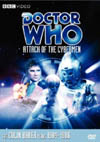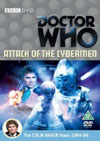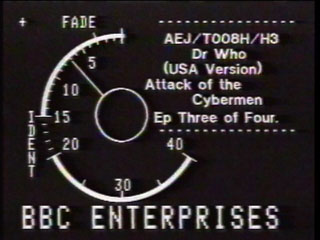DVD Extras include:
There are two basic structural problems running through most of season twenty-two, and "Attack of the Cybermen" is probably the story that avoids them both best. The first problem is in the length of time that it takes for the Doctor and Peri to arrive at the scene of the main action and begin interacting with the guest characters. Very often, the international 25-minute Part One will end just as (or sometimes before) our two regulars take their first step out of the TARDIS. It makes one wonder why we needed all those scenes establishing guest characters before our regulars begin to interact with them. Although "Attack of the Cybermen" still manages to appear to waste a bit of time on a sequence with Halley's Comet which doesn't really get the special effects work to properly complement Peri's reaction to it, this story still looks better than most of the rest of the season's stories regarding the problem of getting to the scene on time, because the Doctor and Peri come out of the TARDIS fairly quickly here. However, it is still a bit of a wild goose chase. They interact with no one before climbing back in, and moving on to a second landing. Although they get a nice beat dealing with two characters we saw before in "Resurrection of the Daleks" (story no. 134), it doesn't really make good story sense that they should still be extras with no dialogue. You'd think the Doctor and Peri would question them as they confront them, but instead they continue nattering between themselves as if the policemen aren't there. Indeed, when Part One ends, the Doctor and Peri have still not yet found any guest characters to talk to yet. The beats surrounding the TARDIS and its chameleon circuit are a lot of fun though, and the story remains unique in following through on ideas that are only talked about elsewhere in the series. Additionally, the TARDIS gets nicely demonstrated for those who may start watching the show here. Even if it is still one of the usual season 22 delays, the delay is disguised and the sequences are worthwhile this time. Part One does have one of the best unplanned cliffhangers of the season though. Many mysterious and nasty things have happened to people in the sewers, and as the Doctor and Peri wander off into them, a dark arm shifts into the shot telling us that they are being watched and pursued thus the same is about to happen to them, while the music suggests that this arm belongs to a Cyberman. Too bad there wasn't time to squeeze the next scene into Part One though, because ending on the reveal of the Cybermen probably would have worked better, and cutting to the credits right after Griffiths' scream would have been ideal. I remember I had tried to entice my brother to watch Part One with me when it was first broadcast on TVOntario by letting him know that the title promised that Cybermen were in this story. After the episode he asked me if the Cybermen still looked as good, and I had to think and then say that I hadn't actually seen one yet.
Other than that, all you really need to know is that the Cybermen have dastardly plans, which depend on using either the stolen time vessel that docks on their tomb-like base on Telos, or alternatively they could use the Doctor's TARDIS instead. Like the Borg invasions seen in Star Trek 8: First Contact, the intricate details aren't too important, as many different avenues for achieving their aims could be argued and fought over, and indeed, many unnecessary complications for this idea were excised from the script long before it went in front of the cameras. If there is a piece of continuity that you need to know and this story doesn't give you up front, it is largely to get an idea of who those two policemen are in the earliest segments. They have no scenes with Lytton, to whom they have the deepest ties, nor would the Doctor have ever seen them together with Lytton in "Resurrection of the Daleks" (story no. 134). They get passed by a bit too quickly. It is a great pity that they weren't given the ability to have a few lines, such that the Doctor could interrogate them.
Saward TrademarksWhile this story does spend much time attempting to relive the series' past, and successfully finds much of its dramatic draw from those elements, that essential atmosphere of family exploration that the series used to have in the sixties (and had again in "Four to Doomsday" (story no. 118) and much of season 19) is now mostly dysfunctional, as the dialogue focuses far too much on the irritability of most of the characters, few of whom one can be morally proud of. Indeed, you will find most of the characters arbitrarily divided up into pairs in this story, and with the exception of pairs of Cybermen villains, there is almost constant arguing and nagging going on between them. It tends to slow the plot down a bit, in addition to being unpleasant to watch. This staple of irritability and blame is actually the seed for the passive-aggressive syndrome that so often defines Eric Saward character arcs. One wonders to what extent he might falsely believe irritability and blame to be universal truths inside every being. While it may be continually debatable how much of this script was written by Saward and how much actually came from Paula Moore / Paula Woolsey, one thing is certain. Saward's trademarks are all over this one.It is also interesting to note, that of the pairs of characters in the story, the Doctor and Peri often don't seem to be the most important one. Lytton and Griffiths are seen to upstage them at many points, not least of all since they get around to more of the story's settings and interact with more characters, stirring the drink and impacting the plot a bit more, and having more serious confrontations with the main villains. Saward's fixation on mercenaries is in evidence again, and you have to wonder if he didn't think such characters were better at dealing with violent villains, since the Doctor was meant to be such an advocate of non-violence and clearly opposed to guns. Indeed, much of the Doctor's time on Telos is spent in the prisoner dynamic, which is additionally bizarre considering what he accomplishes during those scenes - forging an alliance with a rebellious Cryon, discovering a means of destroying the base on Telos, and both forming and carrying out the plan that wins at the end of the day. Mind you, I like that he tackles all these things - it keeps the Doctor busy with important tasks. It just really boggles the mind that the script would have him do all this from within the prisoner dynamic. It applies a drag on viewer interest, I think, and really stretches credulity that the Cybermen would lock him up in the same room with explosives and rebel elements, and not do better at confiscating his gadgets. Once more we see Colin's Doctor aggressively using violence during the final moves of the story, with Saward-style painful screams ringing loudly there as elsewhere in the story. But this is not the "final fix" to resolve the plot, which the Doctor actually set-up earlier in Part Four. This is a separate rescue beat that satisfies the need to give the main character a final confrontation with the lead villains, all while the fate of another important character hangs in the balance. This beat is probably more justified in ending where it does than a similar beat at the end of "Earthshock" (story no. 122), but all things considered, the violence here does loudly overshadow the "rescue" to the point where "Earthshock" still has a much better feel to its ending. And many fans speculate on what happened with the chameleon circuit at the end of this story, since the TARDIS reverted back to the police box for good here, with no explanation offered. As far as I'm concerned, the chameleon circuit now works, but the Doctor has switched it off after now realizing how much he prefers the exterior the way it was. In essence, the absence of the police box had made the Doctor's heart grow fonder for it. All we know for sure is that he seems pleased that it is back, as most of us fans are too. However, should a future story truly call for something different, by all means turn the chameleon circuit back on for awhile, even if it requires programming the new exterior shape manually. Options are cool. The Cryons are pretty much the only uniquely new element that this story brings to Doctor Who. They are a fascinating concept for a species, well matched to the story, but sadly the production realized them under the same sort of melodramatic paradigm that previously spoiled many of the creatures from "The Web Planet" (story no. 13). But in many ways, it is very critical that we have them in the story, otherwise we'd have to be very hypothetical about who the Doctor and Peri managed to help in this story. Once again, it seems to be the Saward touch that kills off nearly the entire guest cast of the story, upping the violence and eating into the feel-good value of the adventure. Disappointing. But I will give this story a very important point back. This is the only Cyberman story of the classic series, beyond the black and white 1960's, that shows the Cybermen converting humans and assorted humanoid species into more Cybermen. This seems to be way too important a part of who they are to be so ignored. Kudos to this story for showcasing it, particularly in the location scene between Lytton, Griffiths, and Bates, which features in both Parts Three and Four of the international version, giving it some good extra exposure.
Of course, we also have David Banks returning as the definitive Cyber Leader, certainly of this era, but probably of the entire 30+ season franchise as a whole as well I think. And it is just such a lovely mark of respect to bring Michael Kilgarriff back to play the Cyber Controller, after the wonderful work he did elevating the performances of all the Cybermen back in 1967's "The Tomb of the Cybermen" (story no. 37). Granted, Cybermen are realized on screen so differently that audience recognition may be a totally moot point anyway, but Kilgarriff delivers the goods in the role once more under these new challenges, and it is great to have him back.
Not that this is a bad score at all, these are just the reasons why I feel that "The Twin Dilemma" (the previous story) has a better score in terms of new, original material. It is great that Lytton gets a theme though, and it does play in nicer variations as the story progresses. Perhaps best of all in this story are the rich, spooky lead-ins to the Cyber music that feature prominently in the sewer scenes. Clarke is definitely still on form, producing some of the best music ever for Doctor Who.
International Titles:Deutsch: "Angriff der Kybermänner"Magyar: "A kiborgok támadása"Français: (L'Attaque des Cybermen) ou (L'Attaque des Cybernators)Русский: "Атака киберлюдей"Germany also appears to have broadcast the 25-minute international versions of this season's stories, rather than the 45-minute U.K. versions.... This would make sense for anyone buying the entire Colin Baker era at once, intending all the episodes to be able to fit in the same broadcast slot.The French were seen attempting to offer "cybermans" as a translation for this title, which is terrible grammar for either French or English, so I've reconstructed a translation based on the precedents previously set for "Le Règne des Cybermen" (story no. 176), "Le Tombeau des Cybermen" (story no. 37), and "La Revanche des Cybernators" (story no. 79).
This story has become available on DVD and VHS video. Click on the Amazon symbol for the location nearest you for pricing and availability:
Comments on this article are welcome. You may contact the author from this page:
|










